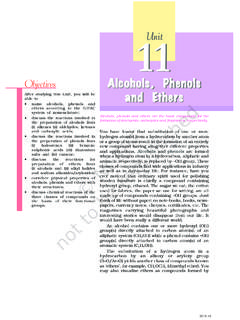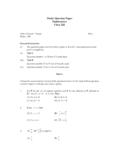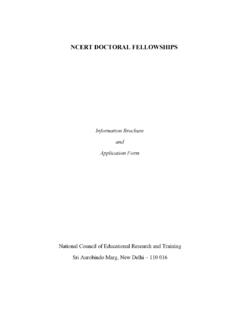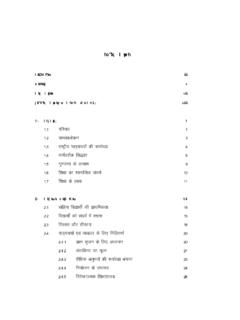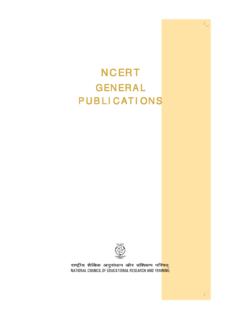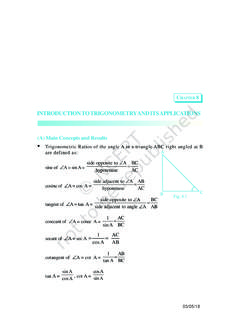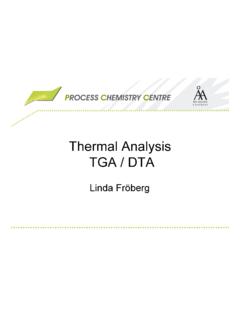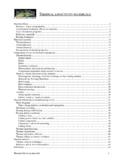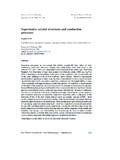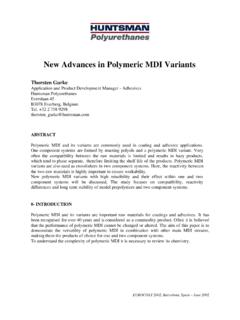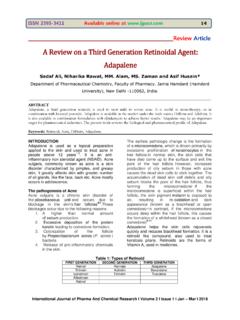Transcription of Objectives d- d- f- f- - National Council Of …
1 the d -block of the periodic table contains the elementsof the groups 3-12 in which the d orbitals areprogressively filled in each of the four long elements constituting the f -block are those inwhich the 4 f and 5 f orbitals are progressively filledin the latter two long periods; these elements are formalmembers of group 3 from which they have been takenout to form a separate f-block of the periodic names transition metals and inner transitionmetals are often used to refer to the elements of d-andf-blocks are mainly three series of the transitionmetals, 3d series (Sc to Zn), 4d series (Y to Cd) and 5dseries (La to Hg, omitting Ce to Lu). The fourth 6dseries which begins with Ac is still incomplete. The twoseries of the inner transition metals, (4f and 5f) areknown as lanthanoids and actinoids speaking, a transition element is defined asthe one which has incompletely filled d orbitals in itsground state or in any one of its oxidation states.
2 Zinc,cadmium and mercury of group 12 have full d10configuration in their ground state as well as in theircommon oxidation states and hence, are not regardedas transition metals. However, being the end membersof the three transition series, their chemistry is studiedalong with the chemistry of the transition presence of partly filled d or f orbitals in theiratoms sets the study of the transition elements andThe The The The The ddddd- and - and - and - and - and fffff-----Block ElementBlock ElementBlock ElementBlock ElementBlock ElementsssssThe The The The the d - d- d- d- d- andandandandand f- f- f- f- f-Block ElementBlock ElementBlock ElementBlock ElementBlock ElementsssssAfter studying this Unit, you will beable to learn the positions of the d andf-block elements in the periodictable; know the electronic configurationsof the transition (d-block) and theinner transition (f-block) elements.
3 Appreciate the relative stability ofvarious oxidation states in termsof electrode potential values; describe the preparation,properties, structures and usesof some important compoundssuch as K2Cr2O7 and KMnO4; understand the generalcharacteristics of the d andf block elements and the generalhorizontal and group trends inthem; describe the properties of thef-block elements and give acomparative account of thelanthanoids and actinoids withrespect to their electronicconfigurations, oxidation statesand chemical , copper, silver and gold are among the transition elements thathave played important roles in the development of human inner transition elements such as Th, Pa and U are provingexcellent sources of nuclear energy in modern (20/01/2015)210 Chemistrytheir compounds apart from that of the main groupelements.
4 However, the usual theory of valence asapplicable to the main group elements can also beapplied successfully to the transition precious metals such as silver, gold andplatinum and industrially important metals like iron,copper and titanium form part of the transition this Unit, besides introduction, we shall first dealwith the electronic configuration, occurrence and generalcharacteristics of the transition elements with specialemphasis on the trends in the properties of the firstrow (3d) transition metals and the preparation andproperties of some important compounds. This will befollowed by consideration of certain general aspects suchas electronic configurations, oxidation states andchemical reactivity of the inner transition TRANSITION ELEMENTS (d-BLOCK) the d block occupies the large middle section flanked by s andp blocks in the periodic table.
5 The very name transition given to theelements of d-block is only because of their position between s andp block elements. the d orbitals of the penultimate energy level intheir atoms receive electrons giving rise to the three rows of the transitionmetals, , 3d, 4d and 5d. The fourth row of 6d is still series of the transition elements are shown in Table general the electronic configuration of these elements is(n-1)d1 10ns1 2. The (n 1) stands for the inner d orbitals which may haveone to ten electrons and the outermost ns orbital may have one or twoelectrons. However, this generalisation has several exceptions becauseof very little energy difference between (n-1)d and ns , half and completely filled sets of orbitals are relativelymore stable. A consequence of this factor is reflected in the electronicconfigurations of Cr and Cu in the 3d series.
6 Consider the case of Cr,for example, which has 3d5 4s1 instead of 3d44s2; the energy gap betweenthe two sets (3d and 4s) of orbitals is small enough to prevent electronentering the 3d orbitals. Similarly in case of Cu, the configuration is3d104s1 and not 3d94s2. The outer electronic configurations of thetransition elements are given in Table in thePosition in thePosition in thePosition in thePosition in thePeriodic TablePeriodic TablePeriodic TablePeriodic TablePeriodic the d -Blockof the d -Blockof the d -Blockof the d -Blockof the d -BlockElementsElementsElementsElementsE lementsScTiVCrMnFeCoNiCuZnZ2122232425262 72829304s22212222123d1235567810101st SeriesTable : Outer Electronic Configurations of the Transition Elements (ground state)2015-16(20/01/2015)211 the d - and f- Block ElementsThe electronic configurations of Zn, Cd and Hg are represented bythe general formula (n-1)d10ns2.
7 The orbitals in these elements arecompletely filled in the ground state as well as in their commonoxidation states. Therefore, they are not regarded as transition d orbitals of the transition elements project to the periphery ofan atom more than the other orbitals ( , s and p), hence, they are moreinfluenced by the surroundings as well as affecting the atoms or moleculessurrounding them. In some respects, ions of a given dn configuration(n = 1 9) have similar magnetic and electronic properties. With partlyfilled d orbitals these elements exhibit certain characteristic propertiessuch as display of a variety of oxidation states, formation of colouredions and entering into complex formation with a variety of transition metals and their compounds also exhibit catalyticproperty and paramagnetic behaviour. All these characteristics havebeen discussed in detail later in this are greater horizontal similarities in the properties of thetransition elements in contrast to the main group elements.
8 However,some group similarities also exist. We shall first study the generalcharacteristics and their trends in the horizontal rows (particularly 3drow) and then consider some group SeriesYZrNbMoTcRuRhPdAgCdZ39404142434445 4647485s22111110124d12456781010103rd SeriesLaHfTaWReOsIrPtAuHgZ57727374757677 7879806s22222221125d123456791010 AcRfDbSgBhHsMtDsRgUubZ891041051061071081 091101111127s22222222126d1234567810104th SeriesOn what ground can you say that scandium (Z = 21) is a transitionelement but zinc (Z = 30) is not?On the basis of incompletely filled 3d orbitals in case of scandium atomin its ground state (3d1), it is regarded as a transition element. On theother hand, zinc atom has completely filled d orbitals (3d10) in itsground state as well as in its oxidised state, hence it is not regardedas a transition (20/01/2015) numberIntext QuestionIntext QuestionIntext QuestionIntext QuestionIntext atom has completely filled d orbitals (4d10) in its ground can you say that it is a transition element?
9 PropertiesNearly all the transition elements display typical metallic propertiessuch as high tensile strength, ductility, malleability, high thermal andelectrical conductivity and metallic lustre. With the exceptions of Zn,Cd, Hg and Mn, they have one or more typical metallic structures atnormal ofProperties ofProperties ofProperties ofProperties ofthe Transitionthe Transitionthe Transitionthe Transitionthe TransitionElementsElementsElementsElemen tsElements(d-Block)(d-Block)(d-Block)(d- Block)(d-Block)ScTiVCrMnFeCoNiCuZnhcphcp bccbccXbccccpccpccpX(bcc)(bcc)(bcc, ccp)(hcp)(hcp)(hcp)YZrNbMoTcRuRhPdAgCdhc phcpbccbcchcphcpccpccpccpX(bcc)(bcc)(hcp )LaHfTaWReOsIrPtAuHghcphcpbccbcchcphcpcc pccpccpX(ccp,bcc)(bcc)Lattice Structures of Transition Metals(bcc = body centred cubic; hcp = hexagonal close packed;ccp = cubic close packed; X = a typical metal structure).
10 Fig. :Trends in melting points oftransition elementsThe transition metals (with the exceptionof Zn, Cd and Hg) are very much hard andhave low volatility. Their melting and boilingpoints are high. Fig. depicts the meltingpoints of the 3d, 4d and 5d transition high melting points of these metals areattributed to the involvement of greaternumber of electrons from (n-1)d in addition tothe ns electrons in the interatomic metallicbonding. In any row the melting points of thesemetals rise to a maximum at d5 except foranomalous values of Mn and Tc and fallregularly as the atomic number have high enthalpies of atomisation whichare shown in Fig. The maxima at aboutthe middle of each series indicate that oneunpaired electron per d orbital is particularly2015-16(20/01/2015)213 the d - and f- Block Elementsfavourable for strong interatomic interaction.
